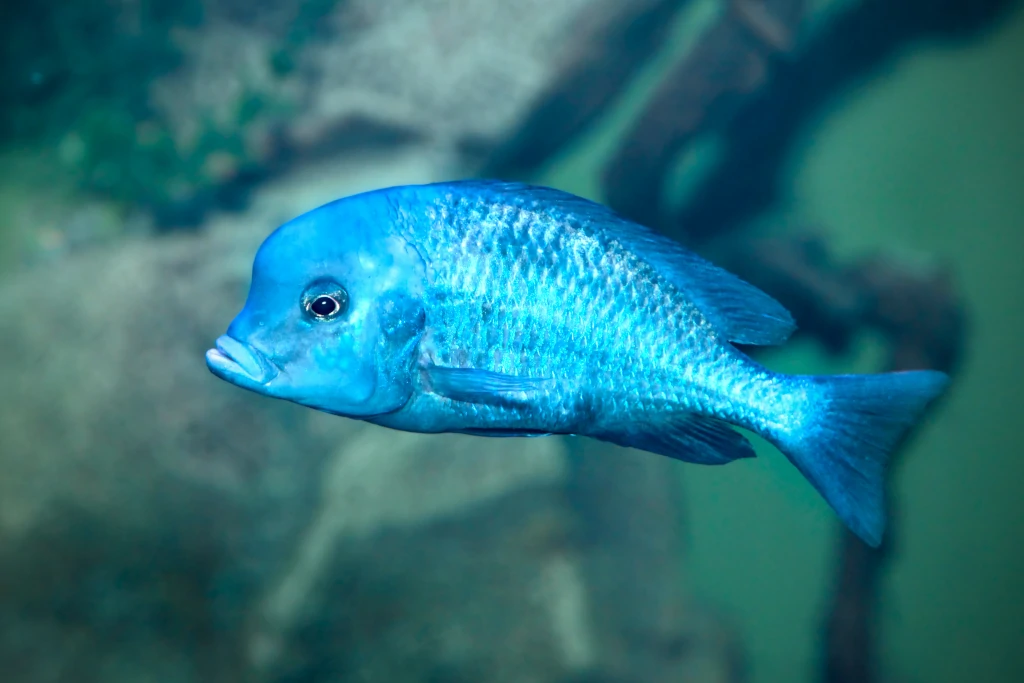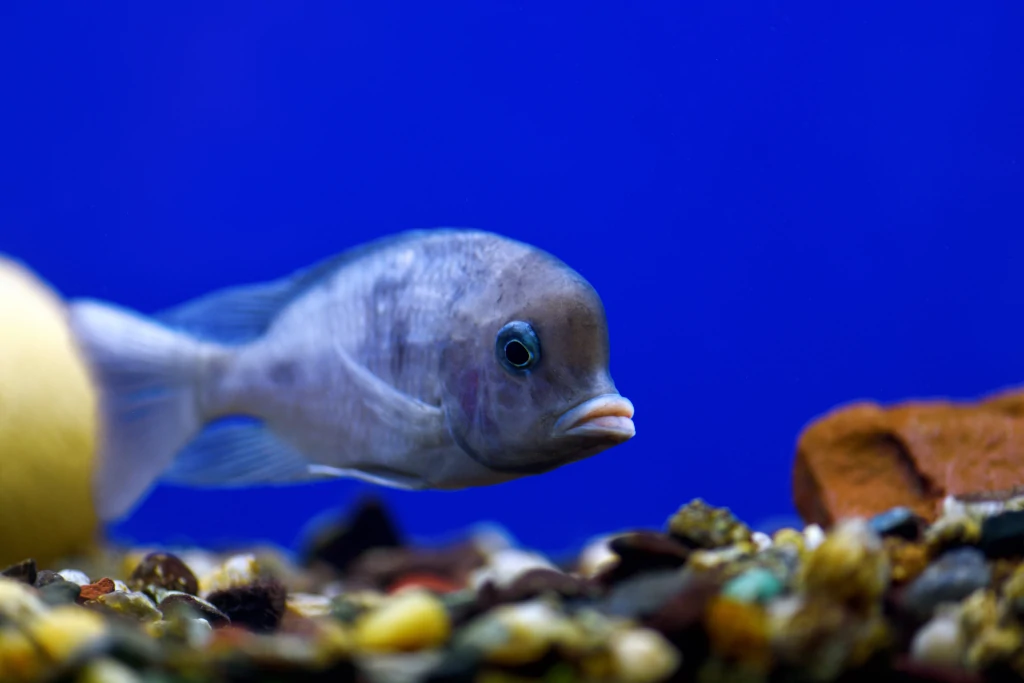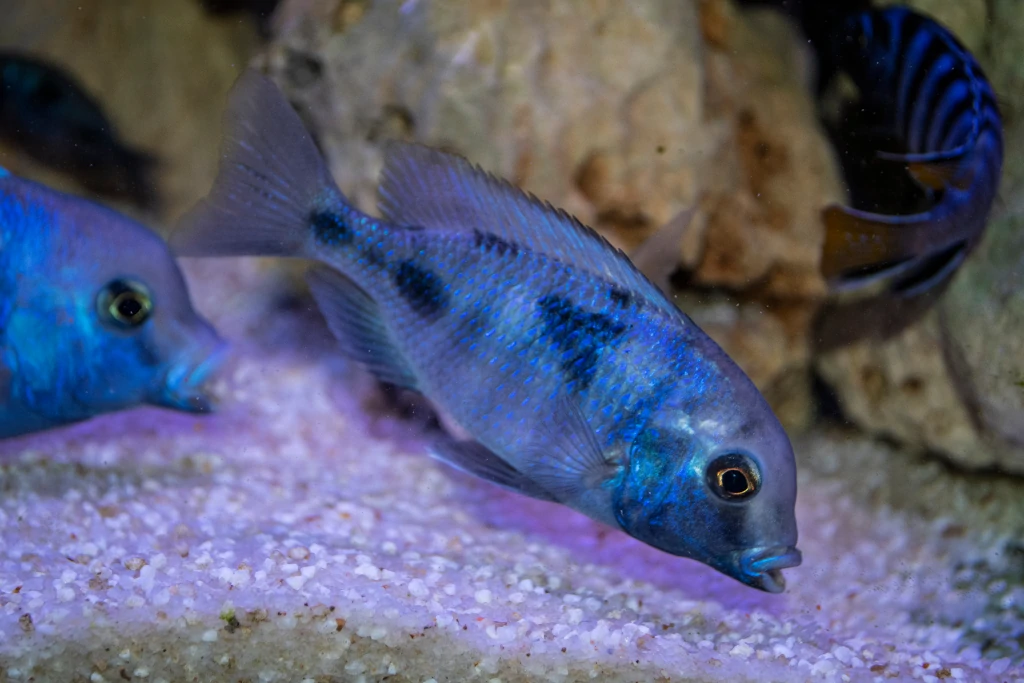
Whether you’re an established aquarium hobbyist or a newcomer setting foot in this realm, the Blue Dolphin Cichlid offers an interesting and rewarding experience. Yet, to ensure this radiant creature thrives in your care, it’s essential to delve into the specific details surrounding its size, lifespan, suitable tank mates, and care requirements.
This guide will unlock the mysteries surrounding the Blue Dolphin Cichlid. From its growth patterns to its ideal habitat, nutritional needs, and compatible companions, we’ll explore every facet to provide you with the most comprehensive information. The more you understand about this mesmerizing species, the more you’ll be equipped to provide an environment where it can flourish.
So, get ready to immerse yourself in the captivating world of the Blue Dolphin Cichlid as we embark on this journey together. Every detail counts when it comes to creating a thriving aquatic environment. Let’s dive in!
| Blue Dolphin Cichlid Stats | |
|---|---|
| Family | Cichlidae |
| Origin | Africa |
| Lifespan | 10 years |
| Temperament | Semi Aggressive |
| Size | 10 inches |
| Diet | Carnivore |
| Minimum Tank Size | 75 gallons |
| Ease of Care | Intermediate |
| Water Temperature | 72°F to 84°F (22-29°C) |
| Water Hardness | 10-18 dGH |
| pH | 7.0-8.0 |
Blue Dolphin Cichlid Species Summary
The enigmatic Blue Dolphin Cichlid, scientifically recognized as Cyrtocara moorii and previously identified as Haplochromis moorii, is a rare cichlid species.
Commonly named the Blue Moorii and the Malawi Blue Dolphin, this fish garners attention with its stout and elongated body, reaching impressive lengths as it matures. Its distinct pointed snout, strikingly reminiscent of a dolphin, played a significant role in the species acquiring its renowned name.
Origin and Natural Habitat
The captivating Blue Dolphin Cichlid hails from the sandy shores of Lake Malawi, one of Africa’s Great Lakes known for its rich biodiversity. In the wild, they inhabit moderately deep, sandy areas, utilizing the lake’s copious rock structures for both foraging and shelter.
Lifespan
When pitted against other aquatic species, the Blue Dolphin Cichlids showcase a remarkable lifespan, albeit this is a variable metric. The lifespan of a Blue Cichlid can fluctuate greatly depending on the quality of care and environment provided.
These cichlids, originating from Africa, live an average of about a decade. Therefore, bringing this fish home signifies a long-term commitment. However, it’s essential to remember the joy these creatures bring, captivating your interest with their behavior and potential companionship once you’ve mastered their care.
Appearance, Colors, & Markings

The Blue Dolphin Cichlid bears a remarkable similarity to its namesake mammal, the dolphin, in the shape and form of its body.
Its most distinctive feature is the pronounced cranial hump, which the Blue Dolphin Cichlid juvenile lacks, and is more prominent in males, earning them the name “blue dolphin.” This prominent feature has led to many names for this species, such as the Malawi Blue Dolphin, Blue Moorii Cichlid, Hap Moorii, Hump-head, Blue Lumphead, and Humphead Mouthbrooder.
Like many freshwater species, Blue Dolphin Cichlids boast a well-formed set of teeth located not just in their mouth but also deep in their throats! In addition, they are equipped with spiny rays on their anal, pectoral, dorsal, and pelvic fins. This array of sharp appendages serves as a deterrent to potential predators.
However, it’s not all defense mechanisms for these unique creatures. In contrast to the spiny rear, the anterior portion of their fins is softer and facilitates effortless swimming.
Adapting to new environments involves a unique process for these cichlids. They draw in surrounding water to get a ‘whiff’ of their new habitat before expelling it using their single nostril on each side of their face. The duration of this scenting process depends on how different the new conditions are from their previous habitat.
When it comes to their coloration, Blue Dolphin Cichlids are adorned with a vibrant blue body, as you may have guessed. However, the monotony is broken by diverse black markings dotting their bodies. These patterns can provide insights into the fish’s original location in the lake. Interestingly, they display a chameleon-like trait during stressful situations when their fins and necks transition to a stark black hue!
Size: How Big Does a Blue Dolphin Cichlid Get?
Comparatively larger than most cichlids, the Blue Dolphin Cichlid, in the wild, tends to grow an impressive 20 to 25 inches. However, in a captive environment, they are typically smaller than their wild counterparts, reaching only an average length of about 10 inches.
The considerable size of this species might pose a challenge to novice aquarists. Therefore, they are best suited to individuals who’ve already had experience in fishkeeping.
Blue Dolphin Cichlid Care

The first step in providing exceptional care for your Blue Dolphin Cichlid involves replicating its mineral-rich natural environment and maintaining a well-oxygenated freshwater condition. While it isn’t a difficult task, it does demand precision and consistent effort. Below are a few tips and guidelines to help you get started.
1. Optimum Tank Size
Housing the Blue Cichlid calls for a generous tank size. The magnitude of the tank plays a crucial role in facilitating the full growth of the fish’s body and its distinct cranial bump.
As such, it’s best to go for a minimum tank capacity of 75 gallons, approximately five feet deep. And the reason you need a large tank of that depth is that these majestic fish typically dwell in the lower and middle parts of the aquarium, often hovering around the sandy substrate.
2. Ideal Water Parameters
The tank’s water parameters form an integral part of the Blue Dolphin Cichlid’s habitat. They thrive in slightly alkaline water, with a pH ranging from 7.0 to 8.0, temperatures between 72°F to 84°F, and water hardness around 10 to 18 dH.
Though they can withstand minor fluctuations in these parameters, maintaining a stable environment is paramount, as with all Lake Malawi fish. For this purpose, having a water testing kit can prove valuable in identifying and rectifying sudden water changes.
Note: Both freshwater and brackish water environments can support these cichlids. Their natural habitats are usually pristine and mineral-rich, a condition you can replicate by introducing a small amount of salt (around 10%) into the tank water.
3. What To Put In Their Tank
Beyond the tank’s dimensions, its interior set-up significantly contributes to your Blue Dolphin cichlid’s well-being. You’ll want to ensure the tank mirrors their natural habitat to help make them feel more at home.
Ideally, the substrate should be sand, as these cichlids enjoy burrowing and digging. Saltwater sand, crushed coral, or aragonite sand can replicate their natural environment, although regular fish tank sand can also suffice.
While plants can be an attractive addition, they’re likely to get uprooted and consumed by the fish. Instead, opt for floating plants or mosses sparingly, and ensure ample swimming space.
For decor, you’ll want to incorporate hiding spots using flat stones or driftwood pieces. Also, aim to keep it simple, minimalistic, yet functional, as you don’t want these decors to disrupt the fish’s natural swimming patterns.
4. Tank Filtration and Heater
A crucial component of the tank is an efficient filtration system. Given the substantial size of the tank, an external canister filter is ideal. Regular partial water changes are equally necessary to eliminate any potential ammonia accumulation, which could be detrimental to the fish.
And since they require warmer water conditions, a water heater will also be necessary.
5. Common Blue Dolphin Cichlid Diseases: What To Look Out For
Like any aquatic species, Blue Dolphin Cichlids can suffer from stress and freshwater fish diseases, especially in substandard water conditions. Insufficient filtration, abrupt temperature alterations, or inferior water quality can escalate their stress, weakening their immune response.
Ich is a common fish disease and tends to appear when the fish are most vulnerable. Prompt detection and treatment by gradually increasing the water temperature to 86°F over three days can cure it. If Ich persists post the heat treatment, a copper-based remedy can be used after removing any liquid conditioner.
Hump heads are also susceptible to skin flukes, parasitic, fungal, and bacterial infections.
However, maintaining appropriate water conditions and parameters can largely mitigate these conditions. Always quarantine any new fish, plants, or decorations you plan to introduce to your tank to ensure they’re pathogens-free.
Food & Diet
Blue Dolphin Cichlids are bottom feeders in their natural environment. They are carnivorous and prefer protein-rich food, though their dietary habits are less specialized in captivity.
In fact, captive-bred Blue Dolphins can easily adapt to various food, be it pellets, flakes, bloodworms, earthworms, brine shrimp, or prawns.
That said, it’s imperative to maintain a balanced, nutrient-rich diet as it significantly impacts their growth and overall health. Prioritize high-quality feed and consider including vitamins and supplements in their diet for optimal health benefits.
Contrary to some beliefs, Blue Dolphin Cichlids should not frequently consume warm-blooded food such as beef hearts and pork. The fats and proteins found in these foods do not align with their natural dietary composition.
Including these items in their diet could potentially trigger digestive issues, including intestinal blockages. If you wish to feed these items, ensure they’re offered sparingly and are viewed as occasional treats rather than daily feeds.
When it comes to feeding your Blue Dolphin cichlids, you’ll want to feed them multiple times a day in small amounts rather than a single large feeding and aim for four to five feeding times each day. Additionally, be sure to remove any leftover food after a few minutes to prevent water contamination and buildup.
Behavior & Temperament
Blue Dolphin Cichlids are considered to be one of the more peaceful African cichlids. While they are generally not overly aggressive, they’re not typically suited for a generic community tank due to their territorial tendencies, particularly when spawning.
Besides, they are known to be playful and quite active. In fact, in the right tank conditions with plenty of hiding places, a Blue Dolphin Cichlid will often be seen out and about exploring its environment.
Blue Dolphin Cichlid Tank Mates

Owing to their substantial size, smaller fish may feel threatened and should therefore be avoided. Additionally, you’ll want to avoid housing Blue Dolphin Cichlids with Mbuna species from Lake Malawi due to the Mbuna’s territorial and assertive nature.
One viable option is to house them with other Blue Dolphin Cichlids. In such cases, maintain a ratio of one male to three to four females for a harmonious environment.
If you’re an experienced aquarist eager to create a diverse community tank, here are some species that have been known to coexist peacefully with Blue Dolphin Cichlids:
You May Also Like: Most Popular Types Of Synodontis Catfish
Breeding Blue Dolphin Cichlids
Breeding Blue Dolphin Cichlids in captivity may be challenging, but it is certainly not an impossible feat. These fish are mouthbrooders and engage in polygamous relationships, so you’ll need to pair one male with several females.
To start with, you would need a substantial tank and a keen eye to differentiate the sexes, which can be quite tricky. One approach to simplify this is, to begin with a group of Blue Dolphin Cichlid juveniles, ideally 8 to 10, and raise them until they reach maturity. Once matured, they can be transferred to a separate breeding tank.
The breeding tank should have slightly elevated pH and temperature levels compared to the original tank to stimulate spawning.
As this process initiates, males tend to show increased aggression, while females become more timid. So creating a stress-free environment through appropriate care and maintenance is crucial.
The male Blue Dolphin Cichlid will typically select a location, such as a flat stone, and excavate a pit for the eggs. The male then attempts to lure the female with its bright colors to get her to lay her eggs.
As mouthbrooders, the female will pick up the eggs, and the male fertilizes the eggs. The female typically holds 20 to 90 fry for roughly 21 days. Once released, you can then feed the fry with brine shrimp eggs, baby brine shrimp, and finely ground flake.
Differences Between Male & Female Blue Dolphin Cichlids
Identifying the sex of a fish is a complex endeavor, requiring considerable knowledge and time. This holds true for Blue Dolphin Cichlids, as both males and females develop a similar bump and share coloration traits. However, certain discernable differences make distinguishing between the sexes relatively easier than other species.
One of the fundamental differences lies in the size of the bump – males typically have larger ones. Furthermore, males tend to display brighter body colors than females. Despite being sexually monomorphic, venting is the most straightforward method to distinguish them.
Another useful distinguishing factor is the presence of indicative vertical stripes. Approximately four out of seven male Blue Dolphin Cichlids exhibit these stripes. In contrast, females might display numerous black marks rather than stripes.
Further observations indicate that the male cichlid’s fluke is blue without marks, whereas the female’s fluke exhibits red marks. Additionally, it’s noted that, upon reaching maturity, the male cichlid’s forehead might sometimes turn yellowish. These distinctive features provide a reasonable basis for differentiating between male and female Blue Dolphin Cichlids.
Wrapping Up
There you have it, a comprehensive guide on the Blue Dolphin Cichlid, a majestic and fascinating species that’s a delight to keep in home aquariums. By understanding and implementing the details about their size, dietary requirements, ideal tank mates, and lifespan, you can create a conducive environment for these beautiful creatures to thrive.
Remember, the key to successful Blue Dolphin Cichlid keeping lies in recreating their natural habitat as closely as possible and meeting their specific needs. From providing a sufficiently large tank and maintaining optimal water conditions to ensuring a balanced diet and understanding their breeding habits, every detail plays a crucial role in their overall health and longevity.
Despite the challenges, the effort is well worth the reward. Watching these serene, azure-hued fish flourish in their aquatic home is an experience that truly enriches the joy of aquarist hobby. Keep this guide handy and embark on an exciting journey into the world of Blue Dolphin Cichlids. Happy fishkeeping!
Frequently Asked Questions about Blue Dolphin Cichlids
Q1: How big do Blue Dolphin Cichlids get?
A: In captivity, Blue Dolphin Cichlids typically grow to an average size of 10 inches. However, in the wild, they can reach up to 20 to 25 inches in length.
Q2: Do Blue Dolphin Cichlids originate from Africa?
A: Yes, the Blue Dolphin Cichlid is an African species. They are native to Lake Malawi, one of the African Great Lakes known for its rich diversity of cichlids.
Q3: What’s the recommended tank size for housing a Blue Dolphin Cichlid?
A: Blue Dolphin Cichlids require a substantial tank size to accommodate their size, and the minimum recommended tank capacity is 75 gallons, ideally around five feet deep.
Q4: What water parameters do Blue Dolphin Cichlids like?
A: Blue Dolphin Cichlids prefer slightly alkaline water with a pH range of 7.0 to 8.0. The water temperature should consistently be between 72°F and 84°F.
Q5: What should I feed my Blue Moorii?
A: These carnivorous fish prefer a protein-rich diet. Ideal food options include fish flakes, pellets, bloodworms, earthworms, brine shrimp, and prawns.
Q6: What fish can live with Blue Dolphin Cichlids?
A: They are best housed with other Blue Dolphin Cichlids or mild-tempered fish of similar size. Some suitable tank mates include Peacock cichlids, Frontosa, Synodontis catfish, Plecos, Clown Loaches, Leopard Bush Fish, and Giant Danios.
Q7: How do you differentiate between male and female Blue Dolphin Cichlids?
A: Although both sexes are similarly colored and develop a bump on their head, males generally have a larger bump and brighter body color than females. Vertical stripes or black markings can also be indicative of their sex.
Q8: Can Blue Dolphin Cichlids be bred in captivity?
A: Yes, while it can be challenging, breeding Blue Dolphin Cichlids in captivity is possible. They are mouthbrooders and typically form polygamous relationships, so keeping one male with several females in a breeding tank is best.
More Reading: